Table of Contents
- Introduction
- Editor’s Choice
- Smart Meters Market Overview
- History of Smart Meters
- Smart Meter Specifications Statistics
- Deployment of Smart Meter
- Residential/Domestic Smart Meters Statistics
- Key Smart Meter Investments Statistics
- Key Smart Meter Benefits Statistics
- Concerns About Smart Meters
- Regulations for Smart Meters
Introduction
According to Smart Meter Statistics, Smart meters are advanced digital devices that measure and record energy, gas, or water consumption, transmitting data automatically to utility providers.
Unlike traditional analog meters, meters enable accurate billing, real-time monitoring, and remote data collection, improving operational efficiency and consumer awareness.
They also play a crucial role in smart grid systems by offering detailed usage patterns that help balance supply and demand.
While meters provide significant benefits, such as precise billing and enhanced grid management. Challenges include privacy concerns, initial costs, and technical issues.
Overall, smart meters represent a vital advancement in utility management, enhancing both efficiency and transparency.
Editor’s Choice
- The global smart meter market revenue reached USD 26.5 billion in 2023.
- The market for smart meters is predominantly driven by two key end-user segments. Advanced Metering Infrastructure (AMI) and Automatic Meter Reading (AMR). Advanced Metering Infrastructure holds the majority share, accounting for 59% of the market.
- The global smart electricity meter market revenue is anticipated to reach USD 16 billion by 2027.
- Smart meters typically operate at a nominal voltage of 120V to 240V and can handle current ratings up to 320A. As seen in models like the Aclara I-210+ smart grid meter.
- By 2020, the number of meters installed worldwide had surged to 1,645 million units.
- As of 2021, the deployment of residential meters has varied significantly across different countries and regions. China leads with a full deployment, achieving 100% penetration of meters in households.
- Outside Europe, India’s Ministry of Power aims to replace all traditional meters with smart meters by 2025.

Smart Meters Market Overview
Global Smart Meters Market Size
- The global smart meter market has demonstrated a consistent upward trajectory in recent years at a CAGR of 9.20%.
- In 2022, the market revenue was recorded at USD 24.3 billion.
- The market is projected to continue its growth, attaining USD 51.9 billion by 2031 and further expanding to USD 57.3 billion by 2032.
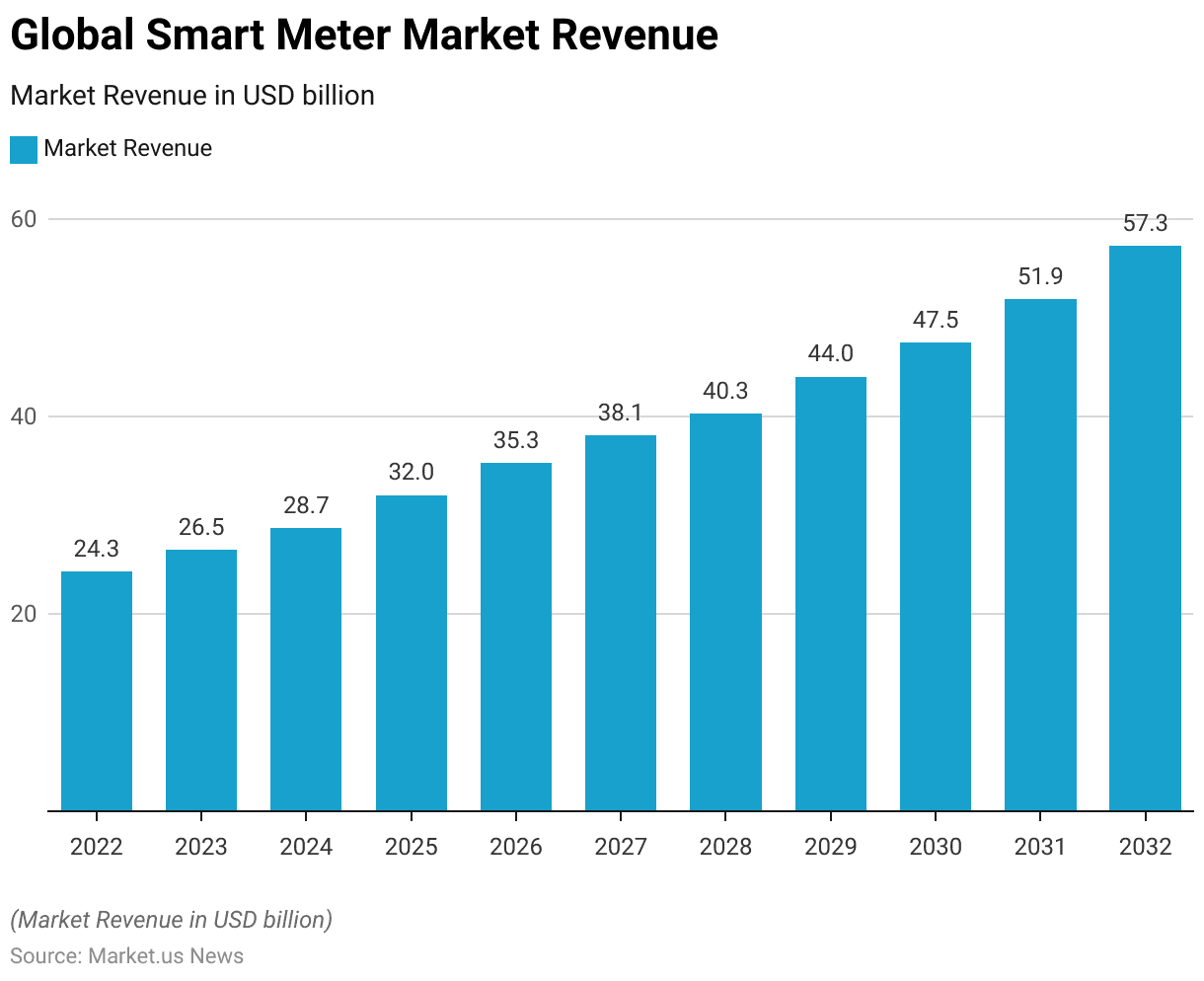
Global Smart Meters Market Share – By End-user
- The market for smart meters is predominantly driven by two key end-user segments. Advanced Metering Infrastructure (AMI) and Automatic Meter Reading (AMR).
- Advanced Metering Infrastructure holds the majority share, accounting for 59% of the market.
- On the other hand, Automatic Meter Reading represents 41% of the market share.
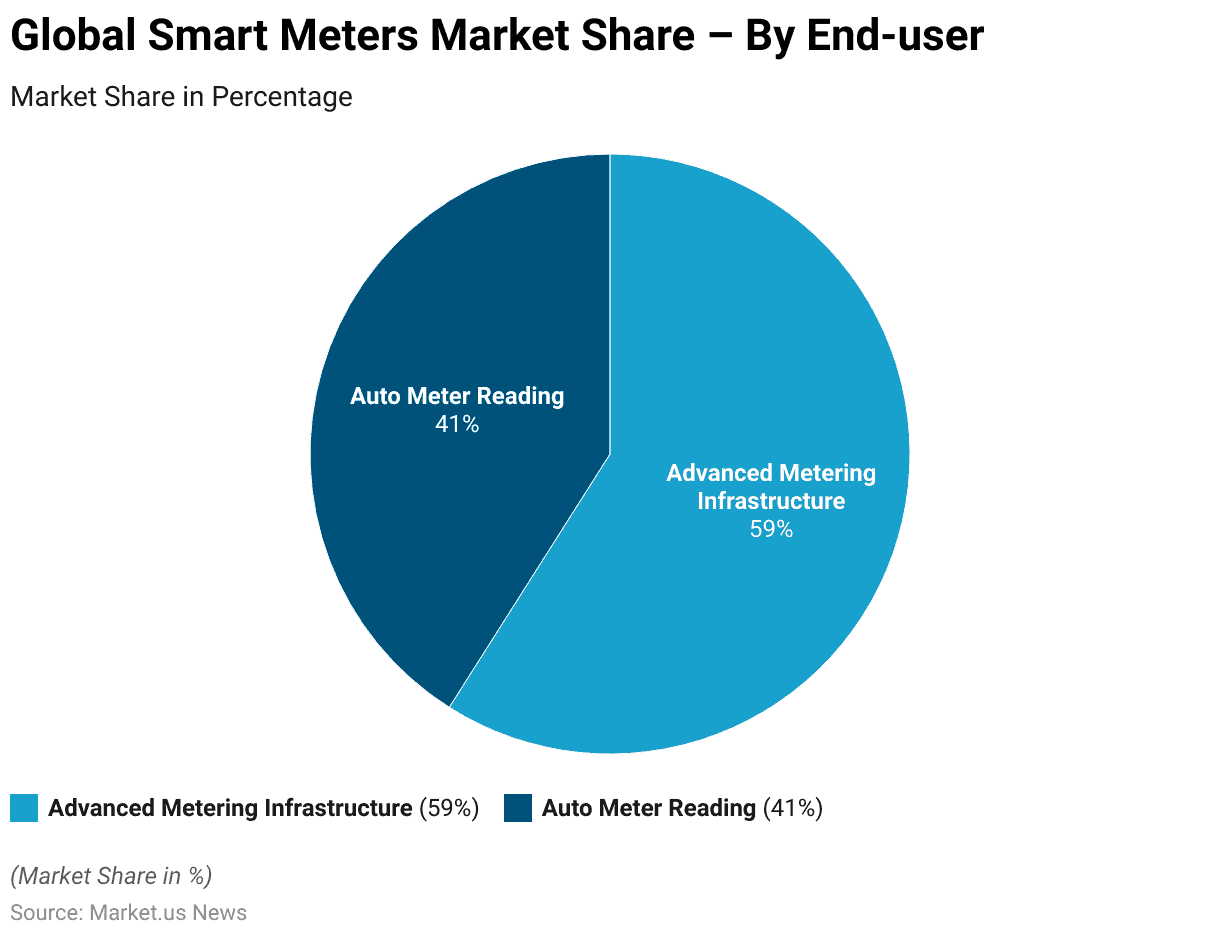
History of Smart Meters
- The history of smart meters reflects a significant evolution in metering technology. Starting with the advent of traditional mechanical meters in the late 19th century.
- By the 1970s, automated meter reading (AMR) technology began to emerge, facilitating remote reading of consumption data.
- The early 2000s marked the introduction of advanced metering infrastructure (AMI). Integrating two-way communication capabilities, allowed for real-time monitoring and data transmission.
- The deployment of meters accelerated around 2006, driven by initiatives to modernize energy grids and improve efficiency.
- By 2012, field testing of smart meters like the Sensus model in Saskatchewan highlighted both the potential and challenges. Including instances of overheating that led to recalls and further refinements.
Smart Meter Specifications Statistics
- Smart meters, integral to modernizing energy grids, come with a range of technical specifications designed to meet various operational demands.
- These devices typically operate at a nominal voltage of 120V to 240V and can handle current ratings up to 320A. As seen in models like the Aclara I-210+ smart grid meter.
- They support frequencies of 50 or 60 Hz and are designed to function within a wide temperature range. From -40°C to +85°C, and relative humidity up to 95%, ensuring reliability in diverse environmental conditions.
- Additional specifications include high measurement accuracy with voltage accuracy of ±0.5% and current/power/energy accuracy of ±1%. Along with communication interfaces such as RF Mesh and PLC for versatile connectivity.
Deployment of Smart Meter
Smart Meter Deployment Worldwide
- The deployment of smart meters, encompassing electricity, gas, and water meters, has significantly increased worldwide from 2014 to 2020.
- In 2014, the number of smart meters installed globally was 575 million units.
- By 2020, the number of smart meters installed worldwide had surged to 1,645 million units.
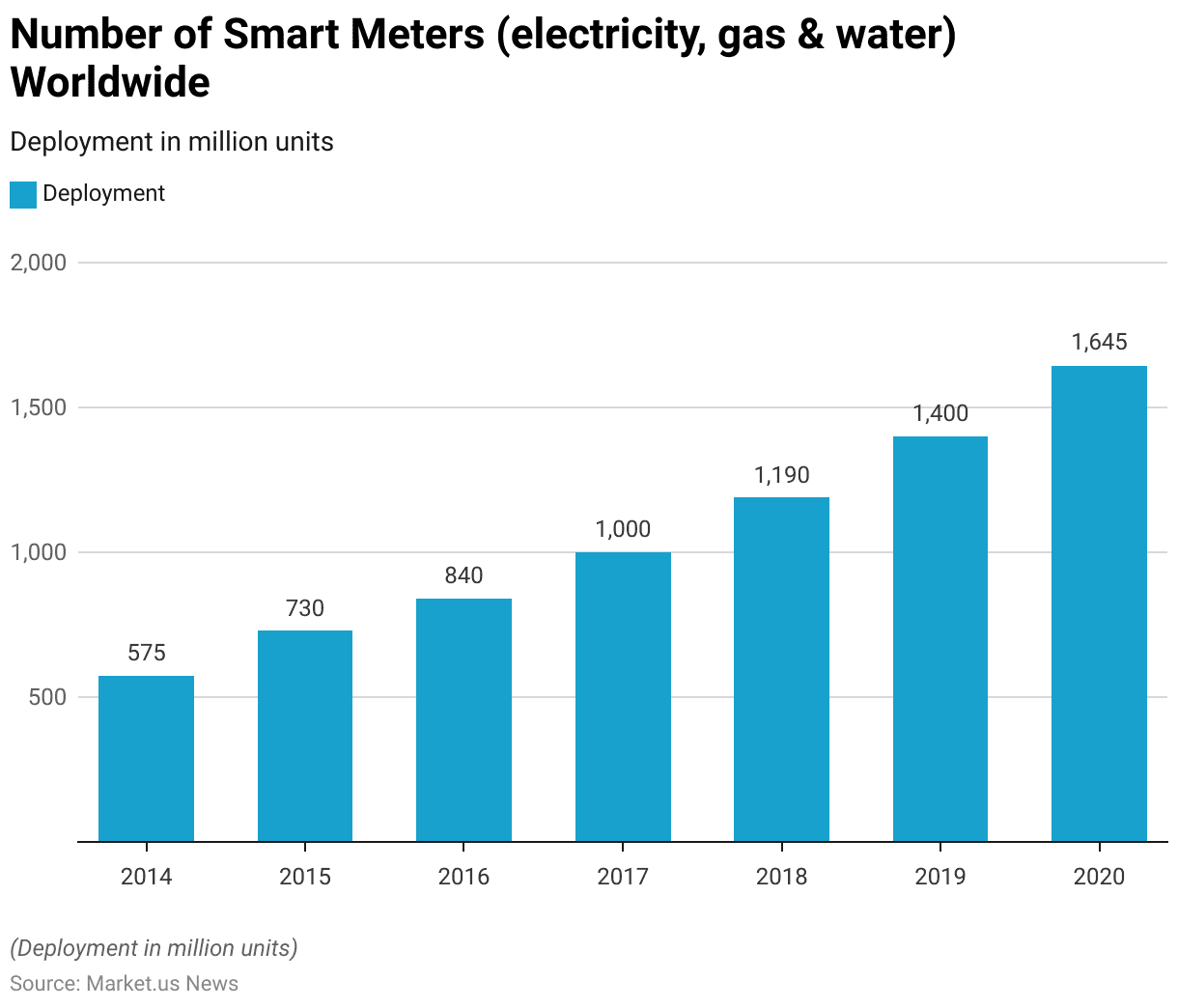
Deployment of Residential Smart Meters – By Country/ Region
- As of 2021, the deployment of residential smart meters has varied significantly across different countries and regions.
- China leads with a full deployment, achieving 100% penetration of meters in households.
- Japan follows with 86% of households equipped with smart meters.
- In the United States, 69% of households have adopted this technology.
- The European Union has a 52% deployment rate, reflecting substantial progress but still leaving room for further adoption.
- In contrast, the Middle East and Africa region has a significantly lower penetration rate of 8%, while South and Central America have achieved a 5% deployment rate.
- India lags, with only 2% of households having meters installed.
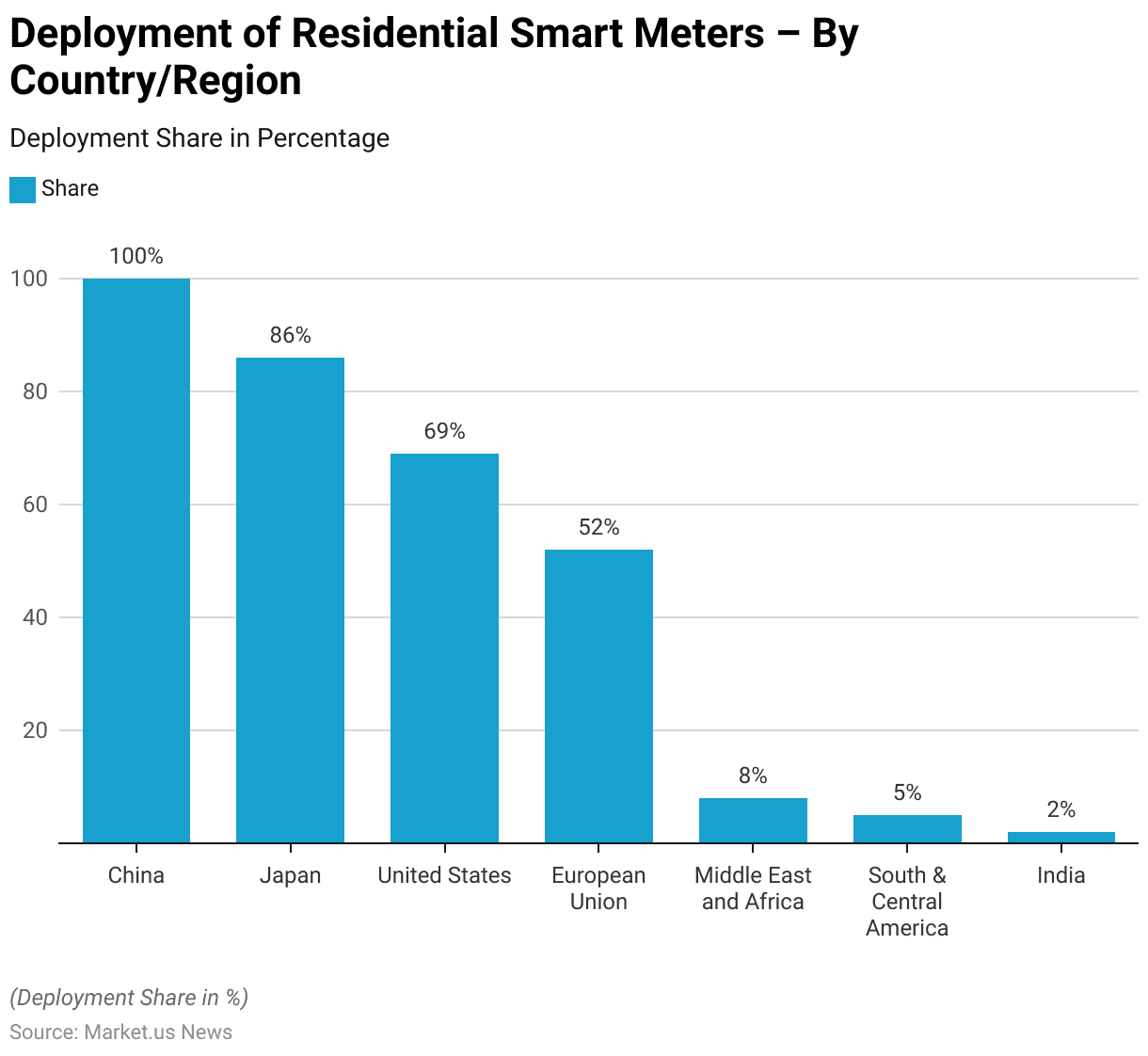
Residential/Domestic Smart Meters Statistics
Domestic Smart Meters Installed – By Type
- From the third quarter of 2012 to the fourth quarter of 2022, the installation of domestic smart meters by large energy suppliers in Great Britain saw substantial growth. In the third quarter of 2012, only 36 electricity and 32 gas meters were installed.
- The first quarter of 2020 recorded 544,126 electricity and 456,490 gas meters, with a noticeable decline by the third quarter to 488,899 and 383,910, respectively. The downward trend persisted into 2021, with installations reaching 435,799 for electricity and 326,957 for gas in the first quarter.
- By the fourth quarter, the numbers slightly recovered to 491,679 and 362,733. In 2022, installations remained relatively stable, with 477,608 electricity and 363,121 gas meters in the second quarter and concluding the year with 516,634 and 398,956, respectively, in the fourth quarter.
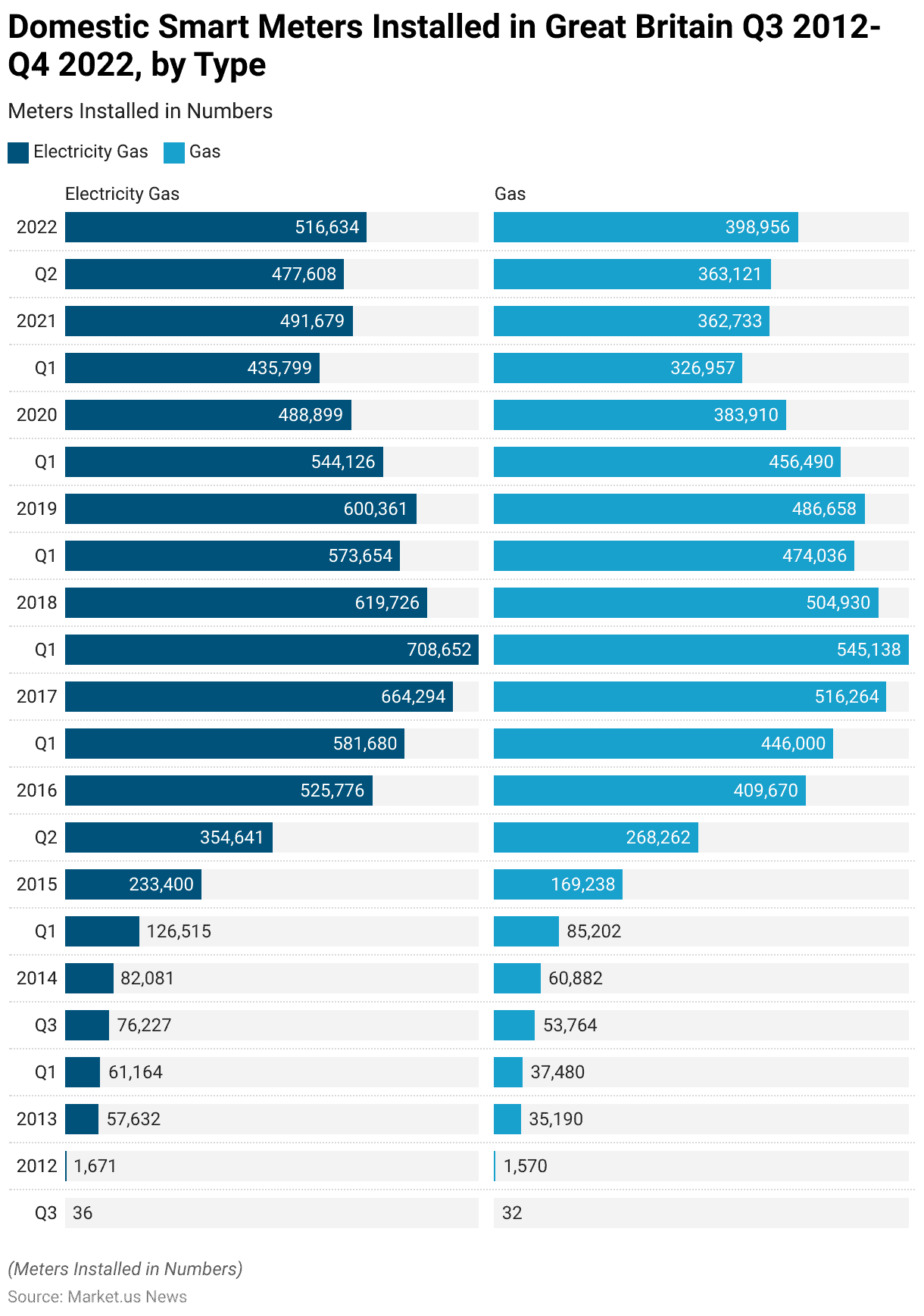
Key Smart Meter Investments Statistics
- Cumulative investments in advanced metering infrastructure (AMI) worldwide have demonstrated significant growth, reflecting the increasing commitment to modernizing energy grids.
- In 2020, global investments in AMI totaled USD 97.4 billion.
- Looking ahead, investments are projected to continue their upward trajectory, with forecasts indicating that by 2025, cumulative investments will reach USD 127.6 billion.
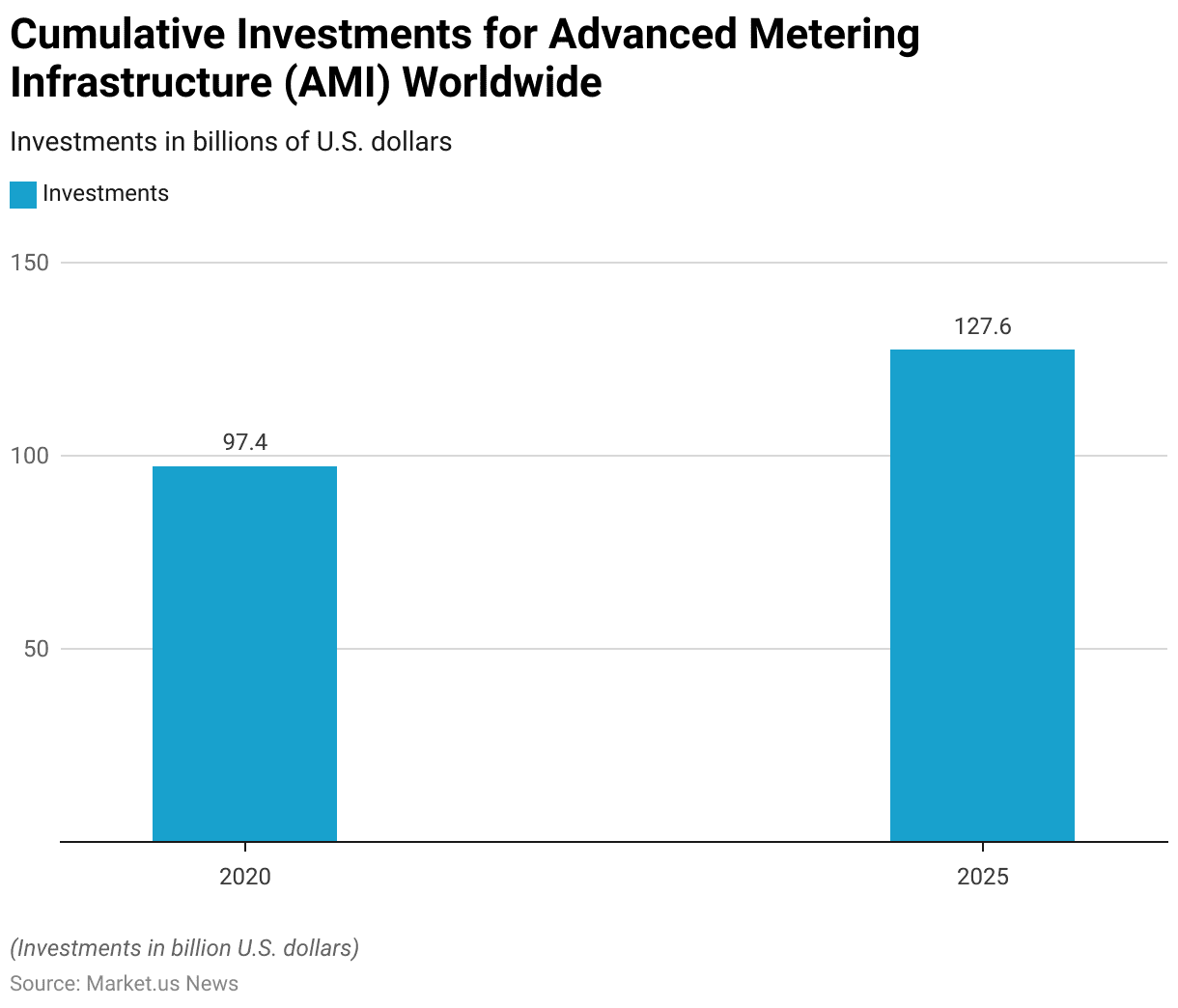
Key Smart Meter Benefits Statistics
- Smart meters provide real-time data logging on energy use, enabling users to reduce consumption and lower their carbon footprint. Research by the Energy Saving Trust indicates that households with meters cut electricity use by 2.8% and gas by 2%, leading to decreased carbon dioxide emissions.
- In Uzbekistan, the World Bank has allocated $46.25 million under the Paris Agreement to cut greenhouse gas emissions and engage with international carbon markets, aiming to reduce emissions by 60 million tonnes of CO2 by 2028. Smart meters are a central part of this effort.
- A 2022 study highlights that smart meters reduce climate change potential by 21%, fossil resource scarcity by 19%, and land pollution by 11%, compared to traditional meters.
- They also support the integration of renewable energy sources like solar and wind, contributing to an anticipated rise in global renewable energy share from 29% to 35% by 2025, as reported by the International Energy Agency (IEA).
Concerns About Smart Meters
- In a recent survey regarding concerns about smart or new meters, the majority of respondents expressed minimal apprehension. Notably, 82% reported having no concerns at all.
- Among those who had voice issues, the top concern mentioned by 4% of respondents was the difficulty in using or understanding the meters.
- Additionally, 2% of participants felt that the information displayed on the In-Home Display (IHD) was too basic.
- In comparison, another 2% were worried that the cost of the meters might be passed on to their energy bills or that energy prices could rise as a result.
- An equal percentage, 2%, expressed doubts about the accuracy of the smart meter readings.
- A diverse array of other concerns was mentioned by 16% of respondents, and 1% indicated they were unsure about any potential issues.
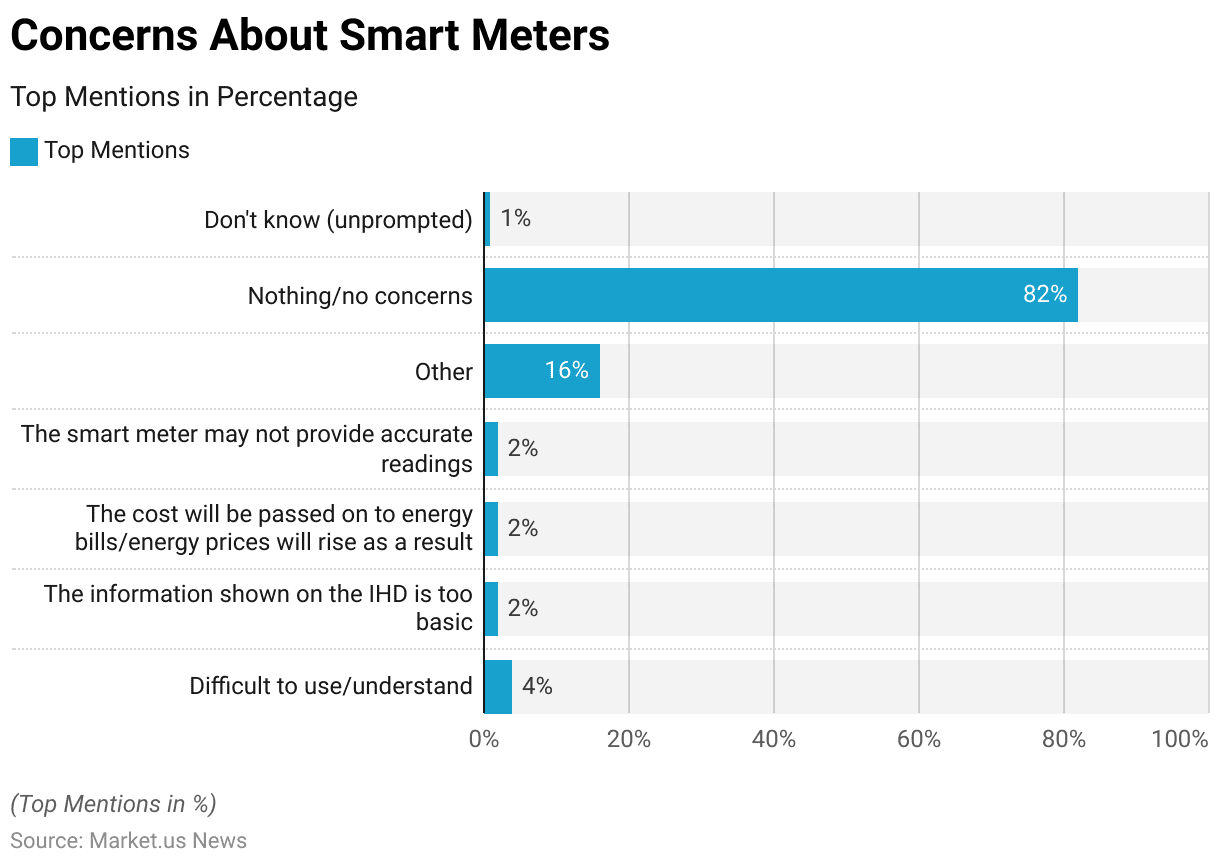
Regulations for Smart Meters
- Regulations for smart meters vary significantly across countries, reflecting diverse national policies and rollout strategies aimed at modernizing energy infrastructure and improving energy efficiency.
- In the European Union, directives such as the Third Energy Package and the Clean Energy Package have mandated that member states ensure at least 80% of consumers have meters by 2020, with many countries exceeding this target.
- In the United Kingdom, the government has set ambitious targets to reach full smart meter coverage by 2025, supported by specific annual installation goals.
- After initial hesitations, Germany has committed to a full rollout by 2030.
- Outside Europe, India’s Ministry of Power aims to replace all traditional meters with smart meters by 2025.
Discuss Your Needs With Our Analyst
Please share your requirements with more details so our analyst can check if they can solve your problem(s)




